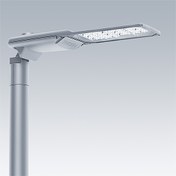Isaro Pro / IP 48L70-740 NR BP 3550 CL2 M60 GY-S
96636179
▼ Data Sheet
A state of the art LED road lighting lantern (medium) with 48 LEDs driven at 700mA with Narrow Road optic. Programmable LED driver. Class II electrical, IP66, IK09. Housing: die-cast aluminium (EN AC-44300), powder coated textured light grey 150 (close to RAL9006). Spigot: die-cast aluminium (EN AC-44300), unpainted. Enclosure: 5mm thick glass. Fixings: spring steel. Supplied with Ø60mm spigot adaptor which can be fitted for post-top (0°/5°/10°/15°/20° tilt) or side-entry (-15°/-10°/-5°/0°/5°/10°/15° tilt). Equipped with 50% power reduction circuit, effective 3 hours before and 5 hours after a calculated midnight. Complete with 4000K LED. Surge protection: 10kV single pulse common mode and 8kV multipulse common mode and 6kV multipulse differential mode. If permanent DALI system is connected, 6kV multipulse common and differential mode.
Dimensions: 718 x 224 x 114 mm
Luminaire input power: 100 W
Luminaire luminous flux: 15566 lm
Luminaire efficacy: 156 lm/W
Weight: 6.93 kg
Scx: 0.066 m²
- LED
- ENEC11 +
- GLedReP
- IK09
- IP66
- Coastal_C5
- LLedNr
- RCM
- SC2 - Protection Class 2

